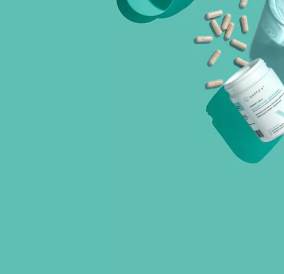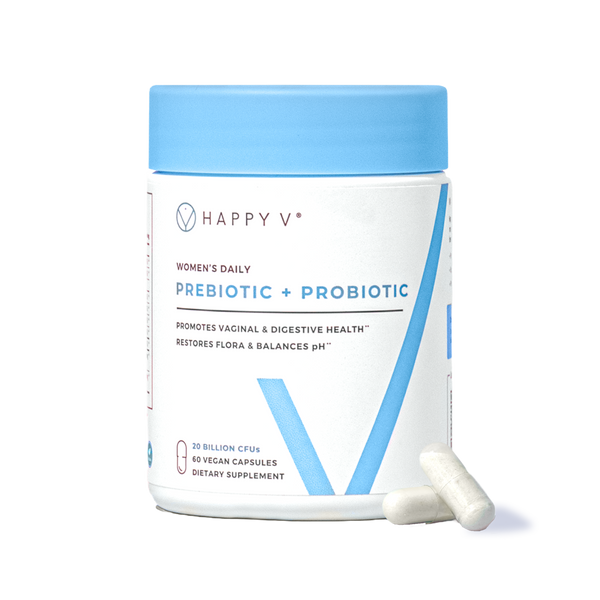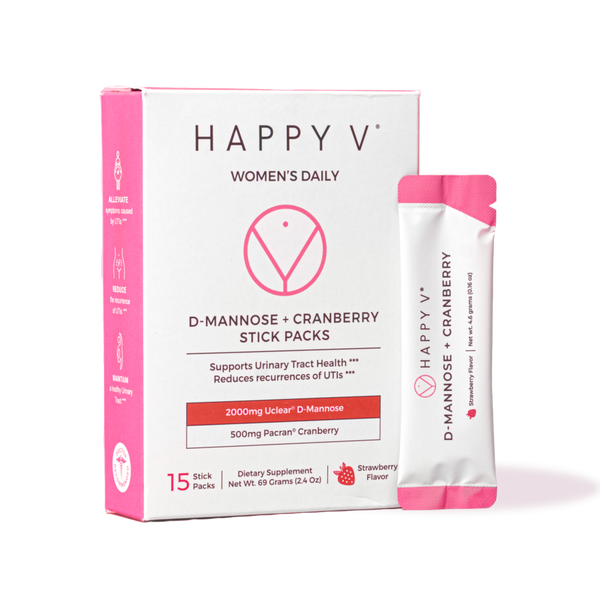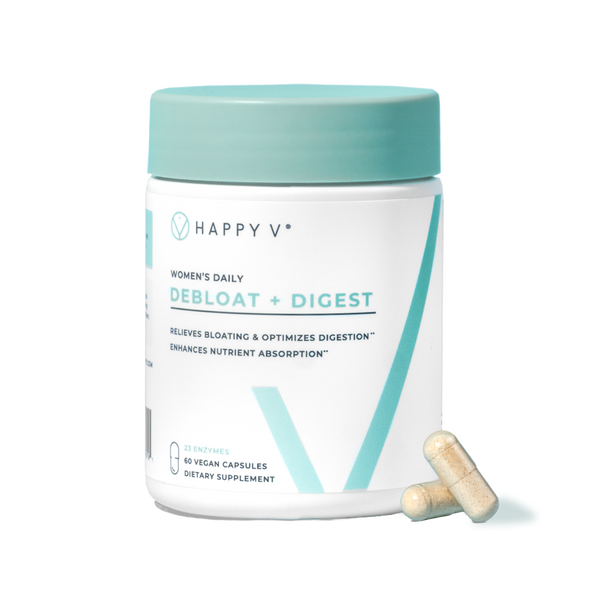- Fact Checked
- April 23, 2024
- 12 min read
Table of Contents
If you are reading this, you are probably pretty health-savvy. And being pretty health-savvy, you have likely heard of vaginal flora and know it’s an essential part of overall vaginal wellness… but maybe you aren’t quite sure what it is or why it is so important. And that’s okay! That’s exactly what we’re diving into today.
By the end of this article, you will understand what the vaginal flora is, how it functions, and how you can keep it (and you!) healthy.
What is the Vaginal Flora?
Vaginal flora, vaginal microbiome, vaginal microflora, genital flora… whatever of these words you’ve heard, they all describe the same thing: the bacteria that reside in your vagina. Just like your gut and digestive tract have bacteria living in them, keeping them functioning properly, so does your vagina. In fact, your vagina is home to trillions (yup, trillions) of microorganisms that keep it at optimal health.
Why is the Vaginal Flora important?
We aren’t ones to overstate things, but the thing about the vaginal flora is that its importance really can’t be overstated. The reproductive system is incredibly complicated; after all, it’s responsible for creating human life, and the vaginal flora keeps this important system balanced.
What is the Vaginal Flora made up of?

So, the short answer is: it’s made up of a whole bunch of microorganisms. The long answer is: the make-up of the vaginal flora is different for every person. Just like our fingerprints are unique, so are our vaginal microbiomes.
Every microbiome contains a mix of good and not-so-good microorganisms, the levels and strains of which vary from person to person.
One good microorganism that we look for that indicates a healthy vaginal flora 1 , and therefor a healthy vagina, is a probiotic or good bacteria called Lactobacillus. There are actually dozens of species of Lactobacillus, some of the most common being:
- Lactobacillus acidophilus
- Lactobacillus reuteri
- Lactobacillus rhamnosus
- Lactobacillus crispatus
- Lactobacillus gasseri
- Lactobacillus iners
- Lactobacillus jensenii
How does Lactobacillus benefit the Vaginal Flora?
So one thing to note off the bat: even though there are many strains of Lactobacillus, not every strain thrives and multiplies in the vagina. Only certain strains, like Lactobacillus Acidophilus LA-14® and Lactobacillus rhamnosus HN001®, have been clinically proven to improve vaginal health. 2 So if you are ever considering taking a probiotic to improve your vaginal health, look at the exact strains being used, and look for one like Happy V’s Prebiotic + Probiotic that uses clinically proven strains.
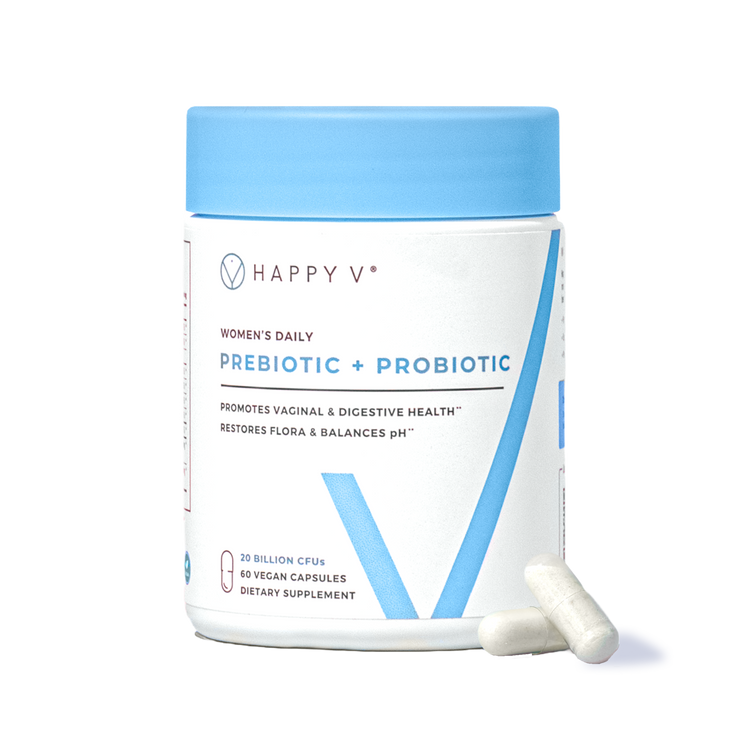
Prebiotic + Probiotic
Maintains vaginal pH and restores gut health.
The way these clinically proven strains work and benefit the vagina is by converting glucose into two essential things: lactic acid and hydrogen peroxide. Let’s start with lactic acid and how it benefits the vagina and protects against infections.
Lactic acid works by keeping the vaginal flora slightly acidic, between 3.8 and 4.7 pH. 3 And if you are thinking, “Wait, what is pH?,” don’t worry, we’ll get into that in just a bit. For now, though, know that a slightly acidic vaginal pH is good because it slows down or completely stops the growth of harmful bacteria within the vagina while still allowing good bacteria to thrive.
Next, hydrogen peroxide. While it’s not a good idea to douche with hydrogen peroxide, naturally produced hydrogen peroxide by way of Lactobacillus is great since it also plays a crucial role in suppressing the growth of harmful bacteria within the vaginal microbiome, such as BV.
What is Vaginal pH?

So if the vaginal flora describes the ecosystem of your vagina, the vaginal pH describes the climate, and certain climates are ideal for allowing good bacteria to flourish while keeping bad bacteria at bay.
At its core, pH describes how acidic or basic/alkaline a substance is. The pH scale goes from 1-14, with 1 being the most acidic (think: battery acid) and 14 being the most basic (think: drain cleaner). 7 is neutral and is the pH of water.
So the weird thing is, though you hear a lot of talk about keeping vaginal pH “balanced,” this doesn’t mean “neutral.” In fact, the ideal vaginal pH is slightly acidic, between 3.8 and 4.5, which we mentioned earlier.
Why is it important to maintain healthy vaginal pH?

Remember, the vaginal flora is the ecosystem, and the vaginal pH is the climate. And when you change the climate in an ecosystem, you change which organisms thrive and don’t thrive within that ecosystem. So maintaining a healthy vaginal pH level between 3.8 and 4.5 is important for several reasons:
Having optimal vaginal pH protects you from the most common vaginal infections.
As we alluded to earlier, a slightly acidic pH prevents bad bacteria from taking hold in the vagina and causing an infection. Specifically, it stops the pathogens responsible for BV and yeast infections.
Bacterial vaginosis (BV)
BV is the leading vaginal infection among women between the ages of 12 to 51 6, with incidences of nearly 21 million cases annually in the United States alone. Most often, BV is caused by the Gardnerella vaginalis bacteria, and symptoms include vaginal discharge, odor, and itchiness. 7
If you want to learn more about BV, check out our ultimate guide where you can get all your questions answered.
Yeast infections
Also referred to as thrush, yeast infections result from an overgrowth of fungus from the Candidiasis family, the most common being candida albicans. When the vaginal pH is off-balance, candida albicans can enter the vagina and eat the sugars usually consumed by the Lactobacillus, leading to unchecked growth.
It supports overall reproductive health.
If you are planning or plan to become pregnant, ensuring an optimal vaginal pH is one of the best things you can do to support reproductive health since it mitigates the risk of complications during pregnancy, including preterm labor.
It reduces the risk of STDs.
Just as optimal pH prevents infections like BV and vaginal yeast infections, studies have shown that a healthy vaginal flora minimizes the risk of contracting sexually transmitted diseases (STDs) and sexually transmitted infections (STIs).7
Does the normal Vaginal Flora change over a person’s lifetime?

Oh yes. That’s because the vaginal flora is heavily influenced by things like hormonal fluctuations, sexual activity, and overall health, all of which naturally fluctuate throughout a lifetime. It’s actually pretty incredible the amount of transformations the vaginal flora undergoes.
Let’s talk about what the vaginal flora typically looks like at each stage of life.
Birth and childhood
When a mother gives birth, she actually passes a protective layer of her microbiome to her child as they pass through the vaginal tunnel. And if that baby is a girl, the mother’s Lactobacillus colonizes the daughter’s microbiome, which remains relatively stable during childhood, with little to no discharge. The vaginal pH is also higher during this time, above 4.5.
Puberty
Puberty elevates estrogen levels, which stimulates the production of something called glycogen within the vagina. This glycogen will support the growth of the Lactobacillus, so it can release lactic acid and lower the pH level to become slightly acidic.
Reproductive years
Throughout the reproductive years, Lactobacillus remains the dominant player in the vaginal microbiome. pH will shift temporarily due to hormonal fluctuations, like those experienced as part of menstruation and the menstrual cycle, as well as during pregnancy and after sexual activity. But having healthy Lactobacillus levels within the vagina will help prevent these temporary shifts from becoming a more permanent change and get pH levels back to normal.
Menopause
Menopause decreases estrogen levels, which leads to a thinning of the vaginal epithelial cells (vaginal atrophy), a decrease in glycogen production, and a reduction in vaginal fluids (vaginal dryness). These shifts can impact the vaginal microbiome and the Lactobacillus within that microbiome, elevating vaginal pH and increasing the risk of infection.
What things support the Vaginal Flora?

The vaginal flora is complex, and it can be affected by a variety of lifestyle choices, some of which can negatively impact the delicate balance and elevate pH levels which can increase your risk of infection.
Adopting a Fiber-Rich Diet
A balanced, wholefood diet containing proteins, natural fats, and whole grains is crucial to overall health. But when it comes to vaginal health, fibrous vegetables are absolutely essential. These vegetables provide prebiotics, which probiotics like Lactobacillus will ultimately consume. By eating fiber, you enhance Lactobacillus’s ability to flourish in your vagina and throughout your body.
“Prebiotics play an important role in human health. They naturally exist in different dietary food products, including asparagus, sugar beet, garlic, chicory, onion, Jerusalem artichoke, wheat, honey, banana, barley, tomato, rye, soybean, human’s and cow’s milk, peas, beans.”
Practicing safe sex
While you and your partner might be ultra-compatible romantically, your microbiomes might not be. Prioritizing safe sex through condoms reduces the risk of introducing unfriendly microbes or potential infections that could disrupt the vaginal flora.
Choosing the Right Supplements:
Many dietary supplements have been shown to deliver essential micronutrients to your vagina, supporting vaginal health. The most notable of these are:
Probiotics.
We’ve talked a whole lot about probiotics like Lactobacillus and how vital they are to reducing the risk of bv, and a daily probiotic supplement can help keep Lactobacillus in steady supply.
if you’re on the fence about how to choose the right probiotic, check out our article on how to pick the best one.
Bacteriophagic Prebiotics
These are a novel class of prebiotics that offer an advantage over the traditional fiber-based prebiotics you’ll find in leafy vegetables since they don’t inadvertently feed harmful bacteria. These are the prebiotics we include in our Prebiotic + Probiotic.
Cranberry
Daily supplements containing cranberry can help combat urinary tract infections without the added sugar that comes from standard cranberry juices.
D-Mannose
D-Mannose is a simple sugar shown to effectively repel bacteria and eliminate it from the urinary tract. D-Mannose supplements are often available as both a pill and a powder that can be sprinkled onto foods like yogurt.
Maintaining good hygiene
Keep the vaginal area clean and support a healthy vaginal microbiome by washing with mild soap and warm water.
Seeking professional support
While we hope online articles like this are helpful, it’s always best to call a healthcare professional, like your OBGYN who specializes in obstetrics and gynecology, if you are ever experiencing unusual symptoms. They can accurately identify issues and recommend appropriate treatments, ensuring your vaginal health remains optimal.
What things can hurt the Vaginal Flora?

The vaginal flora is complex, and it can be affected by a variety of lifestyle choices, all of which can elevate pH levels and increase your risk of infection.
If you are looking to increase your vaginal health, be cautious about:
Processed food diets
Harmful bacteria love the sugars that come from processed foods, and these bacteria will consume the prebiotics usually reserved for Lactobacillus and generate toxins. Prioritize whole foods, especially low glycemic fibrous vegetables, grains, and starches, for better vaginal health.
Smoking and alcohol
Smoking has been linked to a whole host of adverse health effects, but when it comes to vaginal health, smoking can lower estrogen levels, thin the vaginal epithelium, and disrupt the bacterial balance. 10 Similarly, excessive alcohol consumption can also upset the equilibrium. Quitting smoking and moderating alcohol intake can boost your overall vaginal health.
Antibiotic use
Antibiotics are essential for treating a wide variety of infections, but they are not without side effects. Antibiotics work by killing all the bacteria in your body, including that good Lactobacillus bacteria in the vagina, which leaves you vulnerable to future infections. While one-off prescriptions aren’t always a concern, avoid excessive antibiotic use and consider taking a daily probiotic supplement alongside an antibiotic.
Vaginal deodorants & perfumes
Aggressive soaps, perfumes, and sprays all contain chemicals that can disrupt the vaginal flora, leaving you susceptible to infections. When cleaning the vaginal area, warm water and mild, unscented soap is all you need. These recommendations are based on and align with ACOG guidelines.
Douching
Douching is often framed as good hygiene, but it is really quite harmful. Douching washes away beneficial bacteria, elevating pH levels and increasing the risk of infections.
Sex Toys & Lubricants
Improperly cleaned sex toys can introduce harmful bacteria into the vaginal. Also, the chemicals in lubricants and spermicides can irritate the vagina and disrupt its natural balance. Choose pH-balanced lubricants and avoid additives like scented or flavored varieties, glycerin, and Nonoxynol-9 (N-9), which can damage vaginal tissue and increase STI transmission risk.
Stress
Stress takes a toll on your entire body, including your vaginal health. Elevated cortisol levels from stress can weaken your immune system, leaving you more susceptible to infections4. Prioritize stress reduction through meditation, exercise, and adequate sleep.
Synthetic fabrics
Synthetic fabrics, which lack the breathability of natural materials like cotton, can create an environment conducive to harmful bacteria, potentially leading to infections.
If you have tight, nylon underwear, switch it out for cotton. Cotton allows better airflow, reducing the chances of creating a breeding ground for detrimental bacteria. Additionally, be cautious of staying in damp clothes for extended periods, as this can create an environment ripe for bacterial growth.
Conclusion
Your vaginal flora is as vital as it is unique. Like your fingerprints, it is totally distinctive, hosting diverse types of bacteria and microorganisms that affect your health. Of all these microorganisms, it’s the prevalence of the Lactobacillus species that is most telling when it comes to overall vaginal wellness.
Throughout your life, hormonal shifts, sexual activity, and overall health influence your vaginal microbiota. Still, fiber-rich diets, safe sex, quality probiotic supplements, and good hygiene will help sustain a healthy vaginal environment.
